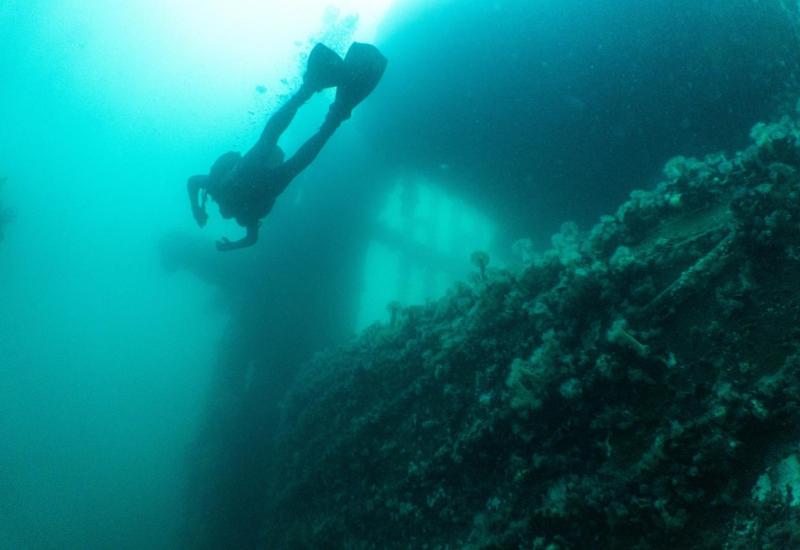How Shipwrecks Corrode

REEF-SMART.COMWreck: Fumizuki
Illustration: 1944-2017
Status: The only genuine warship sunk by Operation Hailstone, this destroyer has deteriorated so significantly that it cannot be preserved and will be gone within a decade, the authors estimate.1) Bridge The bridge and foremast area of Fumizuki has collapsed onto the seabed on the ship’s port side.
2) Funnel Fumizuki’s forward funnel lies crumpled beside the wreck. The aft funnel is intact.
3) Mainmast This feature has disappeared.
4) Stern Fumizuki’s stern has been uplifted, buckled and bent by dynamite fishing.
Ships are made of steel, which starts life as iron ore. Smelting and processing put energy into the ore, turning it into steel. Corrosion is that energy leaking out, turning the steel back into rust, which is basically iron ore. Energy enters the steel as heat but leaves as electrons. Water provides a conductive medium to transfer the electrons; salt makes the water more conductive, speeding the transfer, and oxygen and chlorine dissolved in seawater take the electrons away, which makes seawater a perfect electrolyte.
Exposing the steel to more oxygen — such as in shallower water or areas of faster current — speeds the corrosion. Our survey results showed that the shallower Truk Lagoon wrecks, and those in areas of higher current, are deteriorating more rapidly. Conversely, where a wreck is covered in marine growth, or rust, it restricts the access of oxygen to the remaining steel, slowing the corrosion. This is why dynamite fishing can be so catastrophic to a wreck. Until recently, fishing using explosives salvaged from ammunition on the wrecks was common in Chuuk. As well as being devastating to anything nearby, the explosions shatter the rust layer built up on a wreck over time, exposing it to more oxygen. Many Chuuk wrecks show massively increased corrosion in areas where dynamite fishing has smashed off accumulated marine growth and rust.
CAN TRUK LAGOON BE SAVED?
Higher temperatures also speed corrosion; the survey revealed more-severe damage on the sunny side of shallow wrecks, often balanced by more extensive marine growth, showing the complex factors at work. Also playing a role is the salinity of the water and the pH level (or acidity of the environment).
These key factors are clearly demonstrated in Truk Lagoon. The wrecks located in the deeper and more-sheltered parts of the lagoon are in better condition than those in shallower waters. As depth increases, there is a general reduction in oxygen concentration, temperature and current. These deeper wrecks will still degrade, albeit at a slower rate.

REEF-SMART.COMProtecting the wrecks of Truk lagoon.
How do we protect the wrecks?
1) Sacrificial anode made of aluminum corrodes faster than ship steel, to generate electrons.
2) Electrons flow from the sacrificial anode to the wreck along a connecting cable to wherever corrosion wants to occur.
3) Water and oxygen use the electrons from the sacrificial anode for the corrosion reaction. The sacrificial anode supplies all the electrons the water needs, so no iron loses electrons to form rust. Only the anode corrodes.










